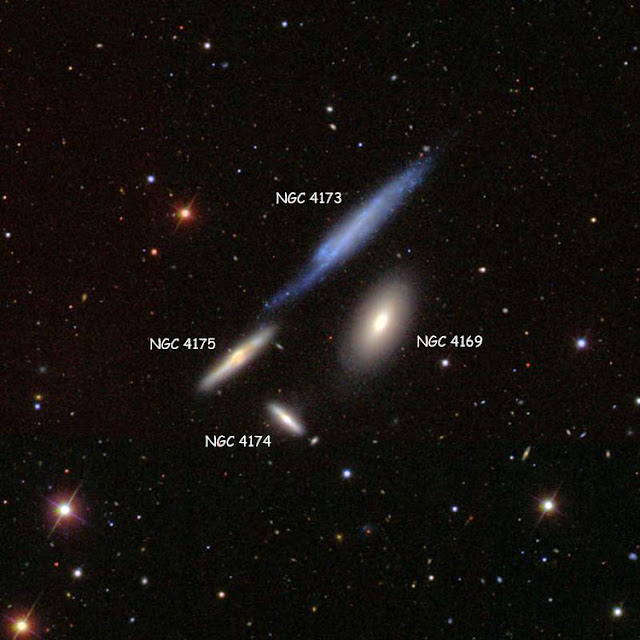At The Eyepiece, March 2021
As I finish up work on Orion, which has taken me several winter seasons to do, I am readying my charts for spring work. For astronomers, spring is a season that zooms past at breakneck speed. These galaxy heavy constellations are visible for far less time than their summer and autumn counterparts. This is because the amount of daylight is increasing rapidly at this time of year, and the constellations appear to move across the sky much faster.
My early spring work is in the constellation of Sextans, and I will have more to say about this area in a future article. For seven years my main spring constellation was Leo, and I still return each year to view favourite objects in that area. But a few years ago I moved on to another constellation that promises to keep me occupied for many more spring observing sessions. Coma Berenices is quite a playground for observers who love galaxies. And the galaxies come in all sizes, shapes, levels of brightness, and groupings. While preparing my pre-observing notes and stats for Coma, I was intrigued to find “The Box” labelled on my Uranometria charts (#54 and #72 of the all-sky edition), and couldn’t wait to see what that was all about.
The Box is a group of four galaxies, roughly in rectangular shape, and can be found in the far north preceding area of Coma, close to the border with Ursa Major. While groups of four galaxies are anything but rare in Coma, photographs certainly do show an interesting group. All of the galaxies are pretty faint, though in good skies a 25cm scope should show three. Here is a list of galaxies and their specs, and a photo from cseligman.com:
eg 4169: 1’.8’ x 0’.9: Visual magnitude 12.2; surface brightness 12.6.
eg 4173: 5’ x 0’.7: Vis. 13; SB 14.2.
eg 4174: 0’.6 x 0’.3: Vis. 13.4; SB 11.4.
eg 4175: 1’.8 x 0’.4: Vis. 13.3; SB 12.8
I had my chance to view these galaxies on May 5th, 2019, using my 30cm Orion Dob. It is a push-to scope, and the group was found easily enough using the little computer. Though all four galaxies can be seen at 136x, 4173 is very faint. Thus it seems more like a triplet. The brightest part of this very faint member lies just north of 4169. And 4169 is the first galaxy one sees, and it remains bright and very oval up to 250x. At 187x a few decent glimpses of the very long and thin 4173 are enjoyed, using averted vision. 4174-75 are easily viewed at 136x, both objects appearing pretty bright, pretty small, with notable stellar cores. At 200x and 250x 4175 becomes quite a bit larger now, and very elongated. In this range 4174 appears a bit brighter that 4175, becoming oval in shape but quite small. I hope you get a chance to view this minor but fun little group someday. The club’s 35 cm scope would be an ideal instrument.
Messier of the Month: Messier 99
Staying within the boundaries of Coma Berenices, but moving about 14 degrees south and a few minutes following The Box, Messier 99 pops into the eyepiece, a bright and nearly round galaxy easily viewed with small telescopes. It was discovered in mid March 1781 by Pierre Mechain, and seen a month later by Charles Messier. My first look came considerably after that, in mid May of 1980. I was at Lake Penage west of Sudbury, and it was a humdinger of a night! It was 3 C and spectacularly clear. I was able to see the galaxy with my 8” scope stopped down to 4”, at 36x. Full aperture showed it relatively large and round. At 56x the galaxy is surrounded by tiny stars, one just within the outer haze of the arms. 72X offered the best view. While the centre remains bright at higher powers, the envelope itself starts to fade.
Jump to May 26th, 2020. On May 26th the temps were hovering around 20 C, and conditions were excellent at my Kent County viewing site. I began by using my 20 cm (8”) aperture stop, locating the galaxy at 60x. It had been just over 40 years since I had last seen this object! At full aperture (30 cm) and 100x the core is stellar and very bright. The galaxy is large, showing a very bright centre around the brilliant core, surrounded itself by a large, fainter envelope of haze. Viewing M 99 is like seeing an unresolved globular cluster. 187X and 272x show the envelope to be unevenly lit, no doubt hinting at the spiral arms. A bright area of haze seems to precede the very bright central area, followed by a darker area, and then a brighter area again. It is such views that often give us aperture fever, and makes me wish I had a 1 metre scope (in high Earth orbit)! Longer views are rewarding at high power, so stay with Messier 99, and use as much magnification as conditions allow. Messier 99 is about 50 million light years away, something to think about when viewing it.
Messier 99 (eg 4254): 5’.4 x 4’.7: Visual mag. 9.9; Surface Brightness mag. 13.2.
Mapman Mike


